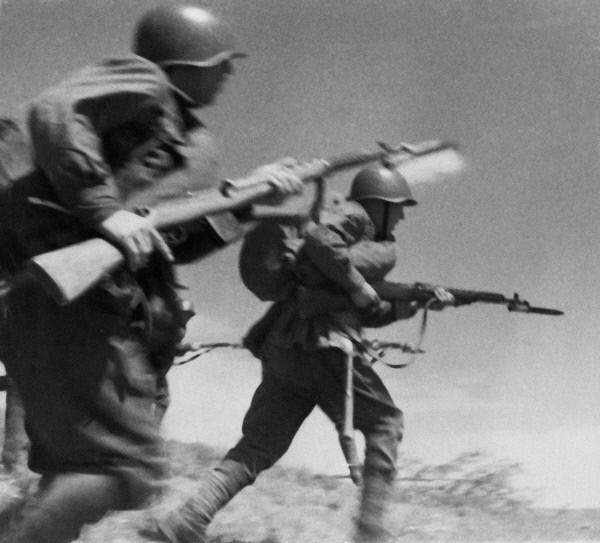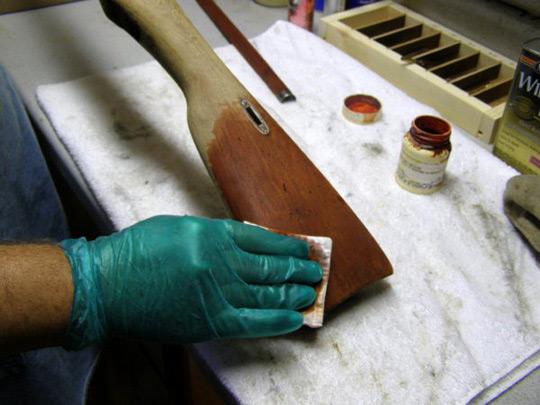-
FREE MEMBER
NO Posting or PM's Allowed

wartime Russian wood finish
Ok - i have a question that has been bugging me - what was the original finish used by the soviet union during ww2?
Most of the soviet rifles I see from ww2 display light coloured wood, but this seems to be the result of postwar rework. Some have a darker, almost redish tone, which i believe was the wartime colour.
but at the same time -

this photo was apparently taken in '41 and shows two distinct shades of stock finish....
anybody have any photos of rifles with wartime finish? any primary sources outlining the finish? experience replicating the finish? I'm looking to restore an SVT 40 to wartime colours
Information
 |
Warning: This is a relatively older thread
This discussion is older than 360 days. Some information contained in it may no longer be current. |
|
-
07-18-2016 12:49 AM
# ADS
Friends and Sponsors

-
Contributing Member


I don't think anyone really knows. I've brought up the topic before and nothing conclusive was ever decided. I've also spoken with numerous Russian re-enactors at various shows to get their opinions. General consensus seems to be that they used an oil finish prior to WWII. Sometime either just before or during the war they started using the red shellac although some say after the war. It is accepted that the shellac became a standard for all refurbishments after the war which is why they all have it now. Complicating matters is that the shellac is basically crap and wears off quite easily and quickly so rifles with it that were used lost most of it pretty quickly.
re-enactors at various shows to get their opinions. General consensus seems to be that they used an oil finish prior to WWII. Sometime either just before or during the war they started using the red shellac although some say after the war. It is accepted that the shellac became a standard for all refurbishments after the war which is why they all have it now. Complicating matters is that the shellac is basically crap and wears off quite easily and quickly so rifles with it that were used lost most of it pretty quickly.
As evidence for all of the above I would look at all Finn capture rifles which appear to not have a trace of shellac on them but an oil finish. Same with Austrian capture rifles from WWI. Most Finn captures would be from the breakup or from early WWII supporting the shellac wasn't in use then. I've seen photos which show rifles with small traces of shellac on them during the war showing the wear problems.
-
The Following 2 Members Say Thank You to Aragorn243 For This Useful Post:
-
Legacy Member

I'm convinced they left the factories with an oil finish or nothing at all in the latter part of the war. The shellac was a Commie make work scheme after the war when the rifles went to storage. Look at RC Mauser's, they got the same crap treatment. This, and the other points Aragorn laid out point in that direction.
Some like to treat the crappy, peeling shellac finish on a $100 dollar rifle as history incarnate. Doing so is fine, just don't handle and never shoot the thing.
-
Thank You to WarPig1976 For This Useful Post:
-
Legacy Member


Originally Posted by
WarPig1976

Some like to treat the crappy, peeling shellac finish on a $100 dollar rifle as history incarnate. Doing so is fine, just don't handle and never shoot the thing.
That shellac is certainly a junk finish, only in rivaled poorness by basement sporter finishing work.
I always strip mine back to a more conventional finish, and you end up with a $100 rifle that at least looks like a $200 gun.
Keeping the shellac is like having a classic car and insisting on keeping it rusty "because it's factory installed rust"...
- Darren
1 PL West Nova Scotia Regiment 2000-2003
1 BN Princess Patricia's Canadian Light Infantry 2003-2013
-
The Following 2 Members Say Thank You to Sentryduty For This Useful Post:
-
Contributing Member


I been messing with some type of true Russian Red Color or close to it. If you go to some Guitar Forums you will find a lot of ways to make this Nice Red Color for what your wanting to put it on.
Red Color or close to it. If you go to some Guitar Forums you will find a lot of ways to make this Nice Red Color for what your wanting to put it on.
Frank
-
-
Legacy Member

I have a wartime dated,1943, Mosin Nagant rifle (U.K. de-ac) which I believe is a Finish capture example as it has the "41" stamp on the receiver but crucially it has never had a full post war refurb. The stock has a natural wood/linseed oil finish. There is no sign of varnish/shellac/stain ever being applied. It just has a general engrained colour that has been achieved by much use/abuse on the battlefield.
finish. There is no sign of varnish/shellac/stain ever being applied. It just has a general engrained colour that has been achieved by much use/abuse on the battlefield.
Remember, it is said that some Russian tanks left the factory in which they were built in bare metal and went straight into battle, things were that desperate.
tanks left the factory in which they were built in bare metal and went straight into battle, things were that desperate.
Last edited by Flying10uk; 07-18-2016 at 01:38 PM.
-
-
Contributing Member


I forgot to attach this Picture to show that these guitar colors come pretty close and there very similar to colors used on Russian Red Furniture. I was reading that Nitro Based Stains are very good to use is this true ? Heidelberg Products are suppose to be the best if they sell it here in the States. I know it's very popular in Europe, but a lot of the very nice AK furniture being restored here are by products sold here so I guess it doesn't matter. I'm just trying to get close for the AK furniture I bought. I been going to lumber yards and picking up scraps for free and using that as practice before I use it on the AK wood I bought.
Red Furniture. I was reading that Nitro Based Stains are very good to use is this true ? Heidelberg Products are suppose to be the best if they sell it here in the States. I know it's very popular in Europe, but a lot of the very nice AK furniture being restored here are by products sold here so I guess it doesn't matter. I'm just trying to get close for the AK furniture I bought. I been going to lumber yards and picking up scraps for free and using that as practice before I use it on the AK wood I bought.
Frank
-
-
Legacy Member

I think that the shellac finish that Russia applied to it's post war refurbs of WW2 weapons was a much thicker finish, like a thick varnished surface. My U.K. deac AKM has more of a stained finish although the colour shade is probably similar.
applied to it's post war refurbs of WW2 weapons was a much thicker finish, like a thick varnished surface. My U.K. deac AKM has more of a stained finish although the colour shade is probably similar.
-
-
Legacy Member

I do know when stripping a Mosin Nagant, SVT-40, or SKS stock to bare wood, the Arctic Birch used in their construction is nearly stark white in colour, almost like a beech without the yellow tint.
Like the colour in this photo that is above the stain, call it weathered pine:

- Darren
1 PL West Nova Scotia Regiment 2000-2003
1 BN Princess Patricia's Canadian Light Infantry 2003-2013
-
Thank You to Sentryduty For This Useful Post:
-
Legacy Member

Surely if the stocks, in at least some case, left the factory with no finish they would pick up/develop a colour of their own in use or to put it another way they wouldn't stay near white for long.
-
















 Register To Reply
Register To Reply










